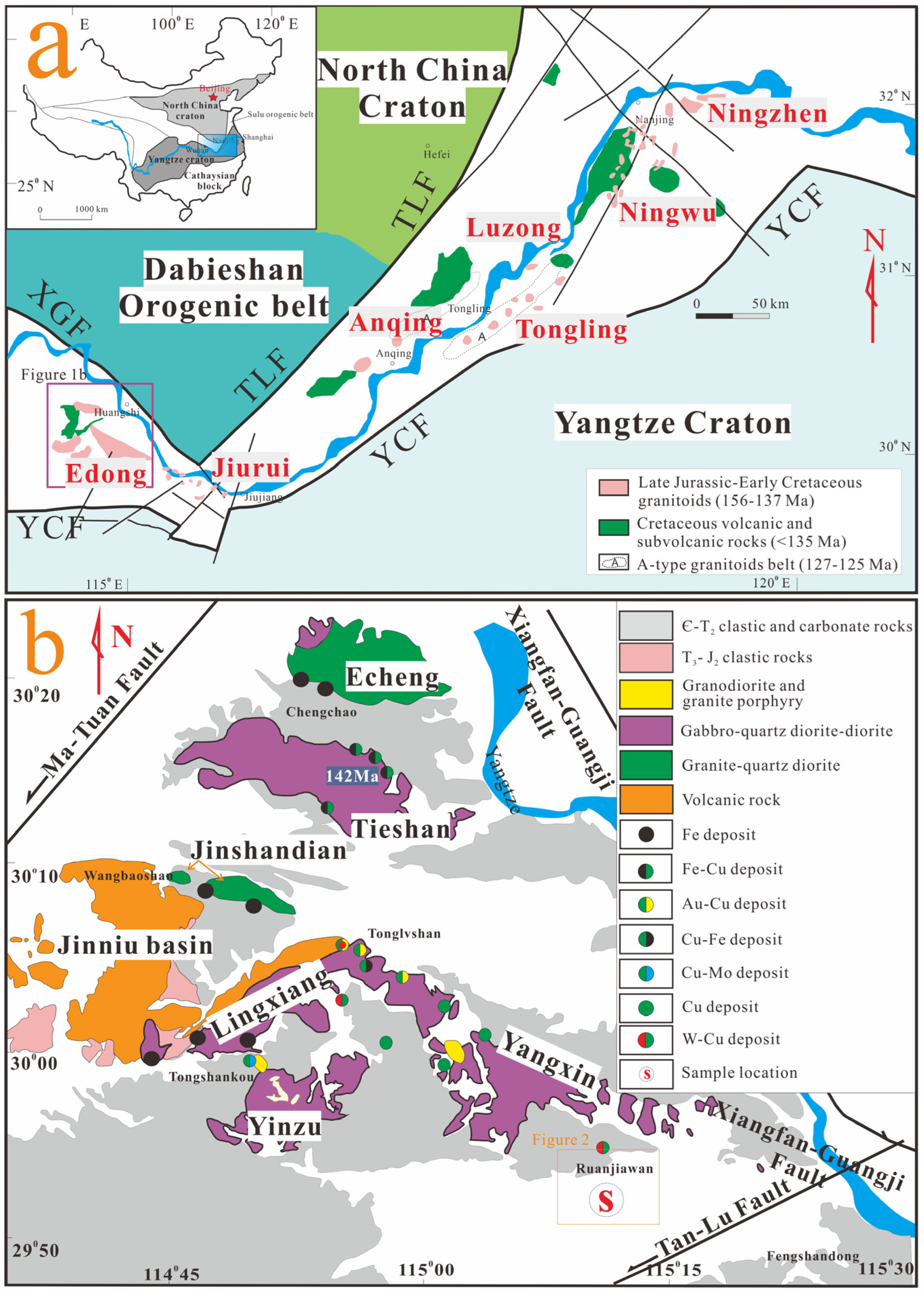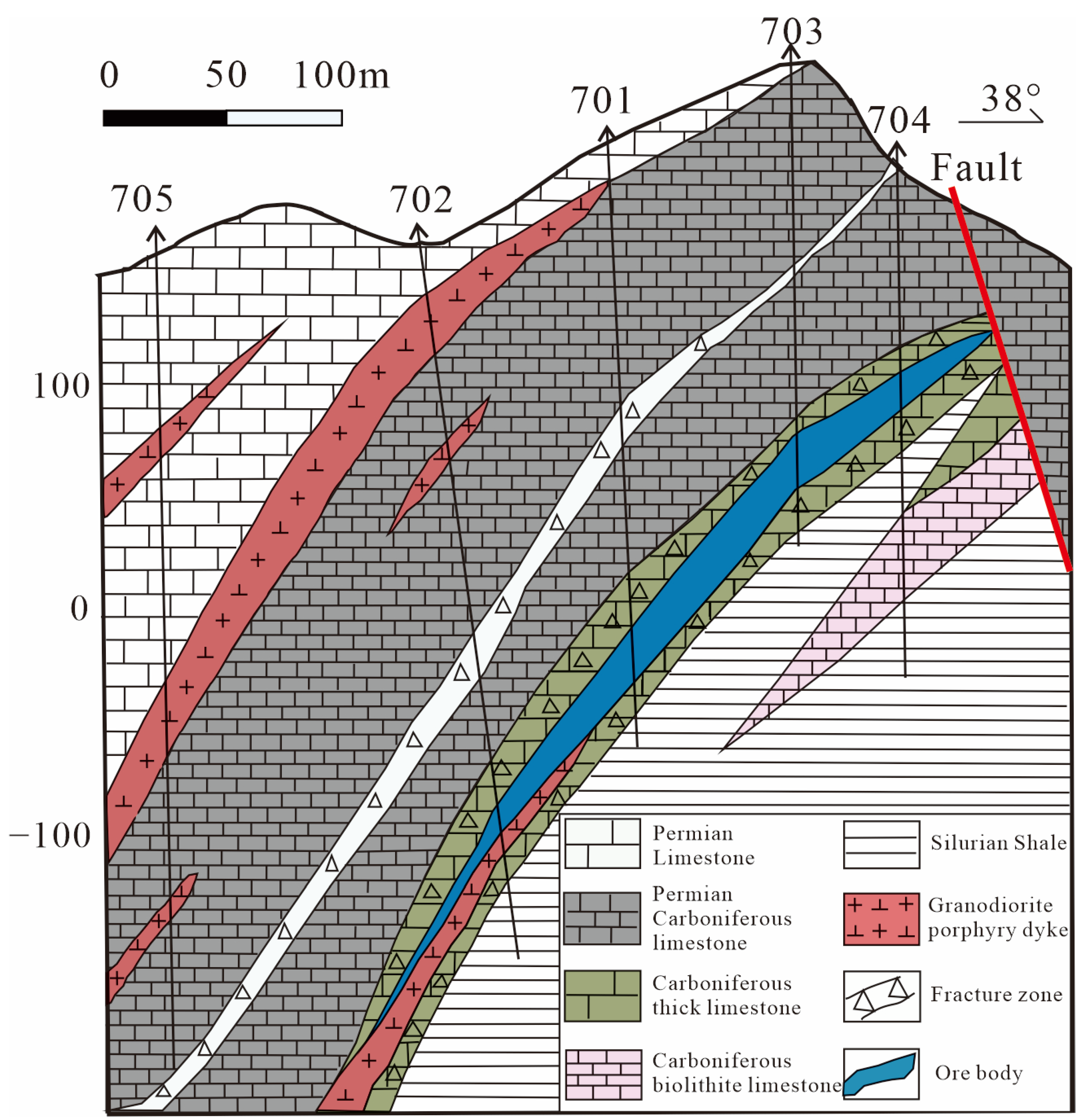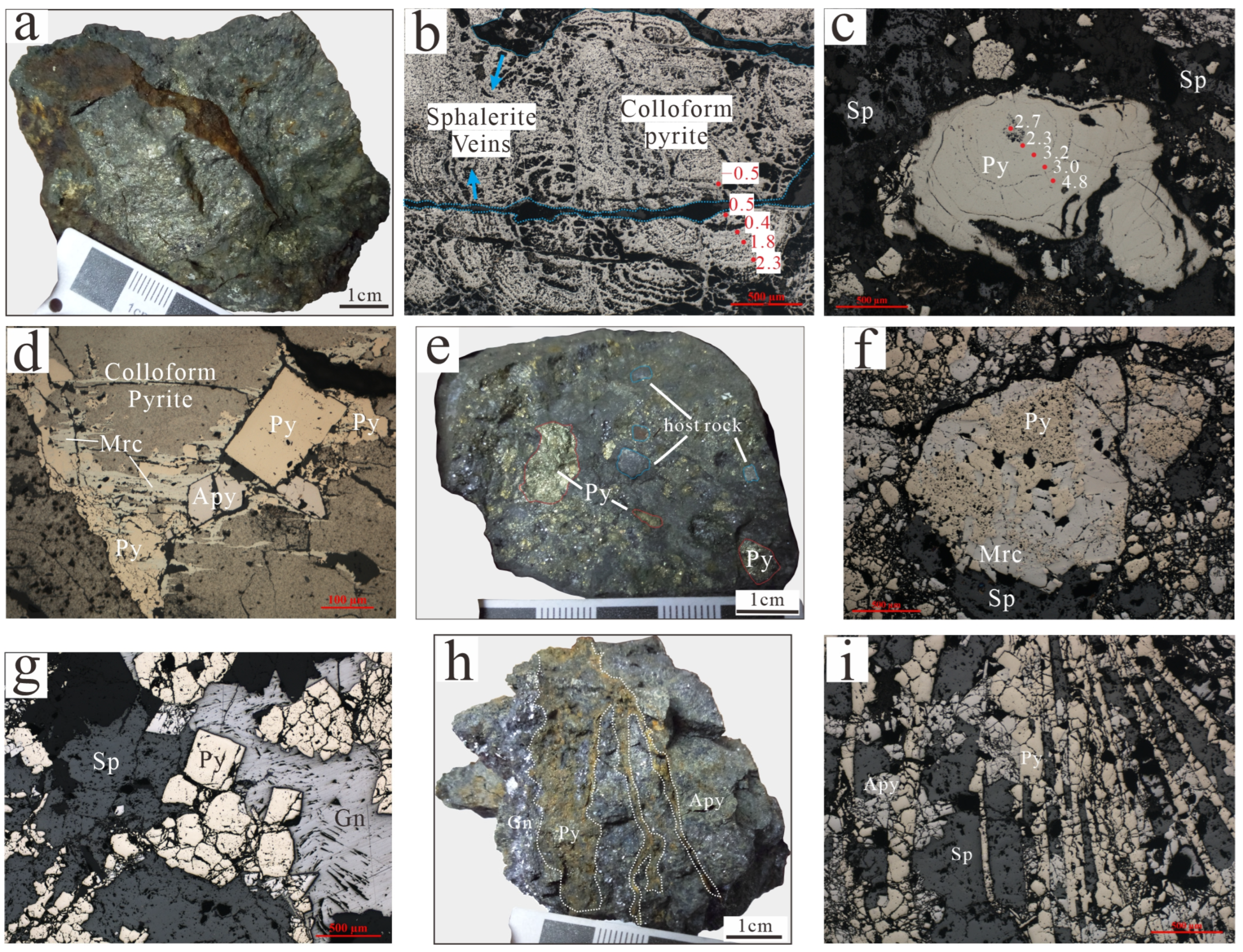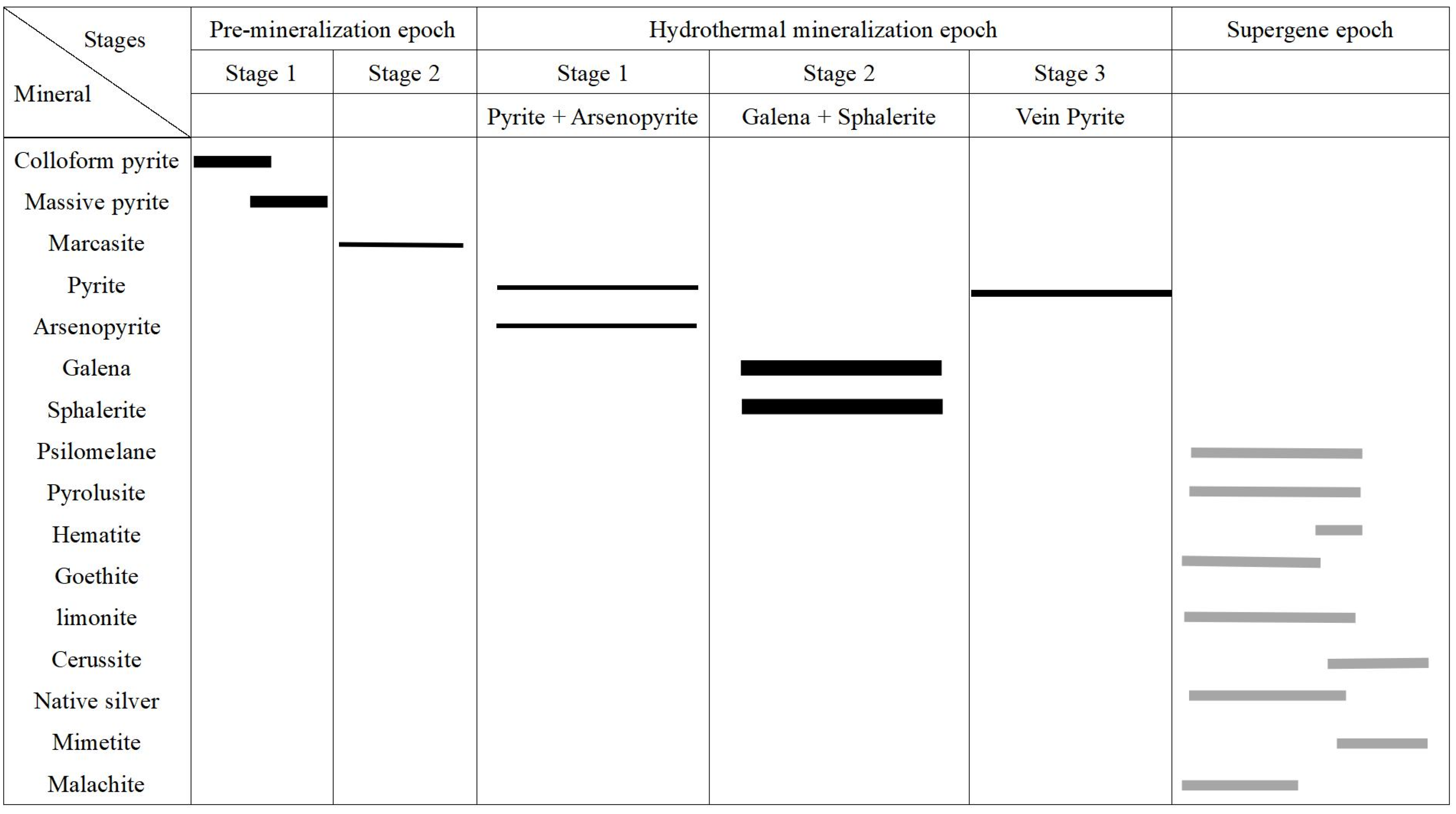Origin of the Yinshan Pb-Zn-Ag Deposit in the Edong District Section of the Middle–Lower Yangtze River Metallogenic Belt: Insights from In-Situ Sulfur Isotopes
Abstract
1. Introduction
2. Regional and Deposit Geology
3. Samples and Analytical Methods
4. Results
5. Discussion
5.1. Source of Sulfur
5.2. Contribution of Colloform and Massive Pyrite to Mineralization
5.3. Possible Parental Magma of Pb-Zn Mineralization in Yinshan Deposit
5.4. Ore Genesis and Its Implications for Exploration Strategies
6. Conclusions
Author Contributions
Funding
Data Availability Statement
Acknowledgments
Conflicts of Interest
References
- Mao, J.; Xie, G.; Duan, C.; Pirajno, F.; Ishiyama, D.; Chen, Y. A Tectono-Genetic Model for Porphyry–Skarn–Stratabound Cu–Au–Mo–Fe and Magnetite–Apatite Deposits along the Middle–Lower Yangtze River Valley, Eastern China. Ore Geol. Rev. 2011, 43, 294–314. [Google Scholar] [CrossRef]
- Zhong, G.X.; Zhou, T.F.; Yuan, F.; Jiang, Q.S.; Fan, Y.; Zhang, D.Y.; Huang, J.M. LA-ICPMS U-Pb Zircon Age and Molybdenite Re-Os Dating of Yaojialing Large Zinc-Gold Polymetallic Deposi, Tongling, Anhui Provinc, China. Acta Petrol. Sin. 2014, 30, 1075–1086. (In Chinese) [Google Scholar]
- Liu, S.F. The Metallogenesis Research of Yaojialing Zn-Au Polymetallic Deposit in Tongling, Anhui Province. Ph.D. Thesis, China University of Geosciences (Beijing), Beijing, China, 2012. (In Chinese). [Google Scholar]
- Liu, Z. The Petrogenesis and Metallogenesis of the Yaojialing Polymetallic Zn-Au Deposit in Tongling City, Anhui Province. Master’s Thesis, Hefei University of Technology, Hefei, China, 2016. (In Chinese). [Google Scholar]
- Yin, Y.D.; Hong, T.Q.; Jia, Z.H.; Zhao, H.; Li, C.; Luo, L.; Huang, J.M. The Re-Os Age of Molybdenite and Ore-Forming Material Source from the Yaojialing Zn—Au Polymetallic Deposit, Tongling. Geol. Rev. 2016, 62, 248–256. (In Chinese) [Google Scholar]
- Liu, G.X.; Yuan, F.; Deng, Y.F. The sphalerite trace element and ore forming fluid character of Hehuashan Pb-Zn deposit, Tongling district, Anhui province. In Proceedings of the ninth National Symposium on Metallogenic Theory and Prospecting Methods, Nanjing, China, 13–16 December 2019; pp. 27–28. (In Chinese). [Google Scholar]
- Liu, S.F.; Du, Y.S.; Fu, S.X.; Zhong, H.; Cao, Y. U-Pb Age and Hf Isotopic Characteristics of Zircons from Granodiorite Porphyry in the Yaojialing Zn-Au Polymetallic Mine, Anhui Province and Their Geological Significance. Earth Sci.-J. China Univ. Geosci. 2013, 38, 91–102. (In Chinese) [Google Scholar]
- Liu, J.M.; Yan, J.; Li, Q.Z.; Song, C.Z.; Liu, X.Q.; Xie, J.C. Zircon Dating and Petrogenesis of the Yaojialing Intrusion in Tongling Area. Chin. J. Geol. 2014, 49, 494–512. (In Chinese) [Google Scholar]
- Meinert, L.D.; Dipple, G.M.; Nicolescu, S. World Skarn Deposits. In One Hundredth Anniversary Volume; Hedenquist, J.W., Thompson, J.F.H., Goldfarb, R.J., Richards, J.P., Eds.; Society of Economic Geologists: Littleton, CO, USA, 2005; pp. 299–336. ISBN 978-1-887483-01-8. [Google Scholar]
- Yan, D.R. Geological Characteristics and Genesis of the Ruanjiawan Cu-Mo-W and Yinshan Pb-Zn-Ag Deposits. Ph.D. Thesis, China University of Geosciences, Wuhan, China, 2013. (In Chinese). [Google Scholar]
- Chen, X.F. Ore-Forming System of Guilinzheng-Huangshanling Deposit in Jiangnan Transitional Zone. Master’s Thesis, Hefei University of Technology, Hefei, China, 2016. (In Chinese). [Google Scholar]
- Tian, K. The origin of Huangshanling Pb-Zn-Mo deposit, Guichi district, Anhui province: Evidence from zircon U-Pb and Pb isotope study. In Proceedings of the Topic 1: Meso-Cenozoic Large Scale Mineralization and Prospecting in Eastern China, Changsha, China, 11–14 December 2015; Volume S1, p. 59. (In Chinese). [Google Scholar]
- Zuo, N. Study on Geological Characteristics and Genesis of the Huangshanling Pb-Zn-Mo Deposit in Chizhou, Anhui Province. Master’s Thesis, China University of Mining & Technology, Xuzhou, China, 2018. (In Chinese). [Google Scholar]
- Ge, N.J.; Li, P.; Huang, X.A.; Zhang, S.B.; Han, Z.Y. Research on physical chemistry condition and materials source of mineralization of Ag-Pb-Zn ore deposit in Yueshan. J. China Univ. Sci. Technol. 1989, 19, 365–374. (In Chinese) [Google Scholar]
- Lan, B.Y.; Yuan, F.; Deng, Y.F.; Cheng, P.S.; Li, X.H.; Zhang, J.M.; Li, Z. In situ trace element composition of sphalerite and ore-forming fluid characteristics of Xiwan Pb-Zn deposit, Anhui Province. Miner. Depos. 2023, 42, 192–210. (In Chinese) [Google Scholar]
- Qian, B.; Yuan, F.; Zhou, T.F.; Fan, Y.; Zhang, L.J.; Ma, L. The geologcial character and sulfur isotope geochemical study on Yueshan Ag-Pb-Zn deposit, Luzong basin. In Proceedings of the Topic 9: Geochemical Tracers of Mineralization and Metallogenic Chronology; Mineral Deposits: Changchun, China, 2010; Volume S1. (In Chinese) [Google Scholar]
- Zha, S.X.; Han, Z.Y. Geochemical characteristics and genetic study of Yueshan Ag-Pb-Zn deposit, Anhui. Resour. Surv. Environ. 2002, 23, 272–280. (In Chinese) [Google Scholar]
- Zhang, H.Q.; Han, S.C.; Zhang, Y.; Pan, J.Y.; Zhang, Y.Q.; Zhao, B.B.; Ding, Y.; Jiang, Y.; Hu, S.P. Trace element characteristics and geological significance of sphalerite in Xiwan lead-zinc deposit, Luzong Basin, Anhui Province. Geol. J. China Univ. 2022. (In Chinese) [Google Scholar] [CrossRef]
- Zhang, Y.Q. Research on the geochemical characteristic and genesis of the Xiwan lead-zinc deposit in Anhui Province. Master’s Thesis, East China University of Technology, Nanchang, China, 2019. (In Chinese). [Google Scholar]
- Liu, G.; Deng, Y.; Yuan, F.; Chen, X.; Yang, B. Rb–Sr Dating and S–Sr–Nd Isotopic Constraints on the Genesis of the Hehuashan Pb–Zn Deposit in the Middle–Lower Yangtze River Metallogenic Belt, China. Solid Earth Sci. 2021, 6, 57–69. [Google Scholar] [CrossRef]
- Jia, L.; Yang, D.; Wang, L.; Long, N. Discussion on characteristics and mineralization of Yanshanian medium-low temperature thermal fluid system in Jiujiang-Ruichang ore concentration area, Jiangxi province. China Min. Mag. 2018, 27 (Suppl. S1), 191–196+210. (In Chinese) [Google Scholar]
- Zhong, H.; Xu, Y.M.; Gao, R.; Dong, Y.Y.; Zhang, L. On Characteristics of Sulfides and Sulfur Lead Isotopic and Trace Elements of the Baiyangfan Lead-Zinc-Silver Deposit in the Jiurui Ore Concentration Area of Jiangxi Province, 2016th ed.; Jiangxi Science and Technology Press: Nanchang, China, 2016. (In Chinese) [Google Scholar]
- Sun, X.J.; Ni, P.; Yang, Y.L.; Qin, H.; Chen, H.; Gui, C.J.; Jing, S. Formation of the Qixiashan Pb–Zn Deposit in Middle-Lower Yangtze River Valley, Eastern China: Insights from Fluid Inclusions and in Situ LA-ICP-MS Sulfur Isotope Data. J. Geochem. Explor. 2018, 192, 45–59. [Google Scholar] [CrossRef]
- Zhang, W.D.; Li, B.; Lu, A.H.; Zhao, K.D.; Elatikpo, S.M.; Chen, X.D.; Zhu, L.; Yu, M. In-Situ Pyrite Trace Element and Sulfur Isotope Characteristics and Metallogenic Implications of the Qixiashan Pb-Zn-Ag Polymetallic Deposit, Eastern China. Ore Geol. Rev. 2022, 144, 104849. [Google Scholar] [CrossRef]
- Zhang, W.D.; You, H.T.; Li, B.; Zhao, K.D.; Chen, X.D.; Zhu, L. Ore-Forming Processes of the Qixiashan Carbonate-Hosted Pb-Zn Deposit, South China: Constraints from Sulfide Trace Elements and Sulfur Isotopes. Ore Geol. Rev. 2022, 143, 104786. [Google Scholar] [CrossRef]
- Xie, S.C.; Yin, H.F. Biometallogenesis of Pb-Zn-Ag Polymetallic Deposit of Qixiashan in Nanjing. Geol. J. China Univ. 1997, 16, 65–74. (In Chinese) [Google Scholar]
- Xie, S.C.; Yin, H.F.; Wang, H.M.; Zhou, X.G.; Zhang, W.H. Characteristics of Ore-Forming Fluids in Pb-Zn-Ag Polymetallic Deposit, Qixiashan, Nanjing. Geol. Sci. Technol. Inf. 1998, 42 (Suppl. S1), 78–81. (In Chinese) [Google Scholar]
- Junquan, L.; Qiuming, T.; Jiangzhou, L. Metallogenic Series of Deposits in Hubei Province; Hubei Science & Technology Press: Wuhan, China, 2005. (In Chinese) [Google Scholar]
- Bendall, C.; Lahaye, Y.; Fiebig, J.; Weyer, S.; Brey, G.P. In Situ Sulfur Isotope Analysis by Laser Ablation MC-ICPMS. Appl. Geochem. 2006, 21, 782–787. [Google Scholar] [CrossRef]
- Chang, Y.F.; Liu, X.P.; Wu, Y.C. The Copper-Iron Belt of the Lower and Middle Reaches of the Changjiang River; Geology Publication House: Beijing, China, 1991. (In Chinese) [Google Scholar]
- Xie, G.; Mao, J.; Xiongwei, L.; Duan, C.; Yao, L. Late Mesozoic Bimodal Volcanic Rocks in the Jinniu Basin, Middle–Lower Yangtze River Belt (YRB), East China: Age, Petrogenesis and Tectonic Implications. Lithos 2011, 127, 144–164. [Google Scholar] [CrossRef]
- Shu, Q.A.; Chen, P.L.; Cheng, J.R. Geology of Iron-Copper Deposits in Eastern Hubei Province; Press of Metallurgical Industry: Beijing, China, 1992. (In Chinese) [Google Scholar]
- Hubei Bureau of Geology. Mineral Resources Regional Geology of Hubei Province; Geological Publishing House: Beijing, China, 1990. (In Chinese) [Google Scholar]
- Li, J.W.; Zhao, X.F.; Zhou, M.F.; Ma, C.Q.; de Souza, Z.S.; Vasconcelos, P. Late Mesozoic Magmatism from the Daye Region, Eastern China: U–Pb Ages, Petrogenesis, and Geodynamic Implications. Contrib. Mineral. Petrol. 2009, 157, 383–409. [Google Scholar] [CrossRef]
- Li, J.W.; Vasconcelos, P.M.; Zhou, M.F.; Deng, X.D.; Cohen, B.; Bi, S.J.; Zhao, X.F.; Selby, D. Longevity of Magmatic–Hydrothermal Systems in the Daye Cu–Fe–Au District, Eastern China with Implications for Mineral Exploration. Ore Geol. Rev. 2014, 57, 375–392. [Google Scholar] [CrossRef]
- Xie, G.; Mao, J.; Zhao, H. Zircon U–Pb Geochronological and Hf Isotopic Constraints on Petrogenesis of Late Mesozoic Intrusions in the Southeast Hubei Province, Middle–Lower Yangtze River Belt (MLYRB), East China. Lithos 2011, 125, 693–710. [Google Scholar] [CrossRef]
- Xie, G.; Mao, J.; Zhu, Q.; Yao, L.; Li, Y.; Li, W.; Zhao, H. Geochemical Constraints on Cu–Fe and Fe Skarn Deposits in the Edong District, Middle–Lower Yangtze River Metallogenic Belt, China. Ore Geol. Rev. 2015, 64, 425–444. [Google Scholar] [CrossRef]
- Craddock, P.R.; Rouxel, O.J.; Ball, L.A.; Bach, W. Sulfur Isotope Measurement of Sulfate and Sulfide by High-Resolution MC-ICP-MS. Chem. Geol. 2008, 253, 102–113. [Google Scholar] [CrossRef]
- Ding, T.; Valkiers, S.; Kipphardt, H.; De Bièvre, P.; Taylor, P.D.P.; Gonfiantini, R.; Krouse, R. Calibrated Sulfur Isotope Abundance Ratios of Three IAEA Sulfur Isotope Reference Materials and V-CDT with a Reassessment of the Atomic Weight of Sulfur. Geochim. Cosmochim. Acta 2001, 65, 2433–2437. [Google Scholar] [CrossRef]
- Xu, L.; Xie, Q.; Zhou, Y.; Wang, J.; Chen, T.; Xu, X.; Xie, J. Recognizing the Evolution of the Stratabound Polymetallic Massive Sulfide Deposits in Tongling Mineralization Cluster, East China through Colloform Pyrite. Ore Geol. Rev. 2022, 146, 104915. [Google Scholar] [CrossRef]
- Ohmoto, H. Sulfur and Carbon Isotopes. In Geochemistry of Hydrothermal Ore Deposits; Wiley: Hoboken, NJ, USA, 1997; pp. 517–611. [Google Scholar]
- Ohmoto, H. Systematics of Sulfur and Carbon Isotopes in Hydrothermal Ore Deposits. Econ. Geol. 1972, 67, 551–578. [Google Scholar] [CrossRef]
- Seal, R.R. Sulfur Isotope Geochemistry of Sulfide Minerals. Rev. Mineral. Geochem. 2006, 61, 633–677. [Google Scholar] [CrossRef]
- Anderson, G.M. Kerogen as a Source of Sulfur in MVT Deposits. Econ. Geol. 2015, 110, 837–840. [Google Scholar] [CrossRef]
- Kesler, S.E.; Jones, H.D.; Furman, F.C.; Sassen, R.; Anderson, W.H.; Kyle, J.R. Role of Crude Oil in the Genesis of Mississippi Valley-Type Deposits: Evidence from the Cincinnati Arch. Geology 1994, 22, 609–612. [Google Scholar] [CrossRef]
- Drummond, S.E.; Ohmoto, H. Chemical Evolution and Mineral Deposition in Boiling Hydrothermal Systems. Econ. Geol. 1985, 80, 126–147. [Google Scholar] [CrossRef]
- Giggenbach, W.F. Geothermal Gas Equilibria. Geochim. Cosmochim. Acta 1980, 44, 2021–2032. [Google Scholar] [CrossRef]
- Schaarschmidt, A.; Haase, K.M.; Klemd, R.; Keith, M.; Voudouris, P.C.; Alfieris, D.; Strauss, H.; Wiedenbeck, M. Boiling Effects on Trace Element and Sulfur Isotope Compositions of Sulfides in Shallow-Marine Hydrothermal Systems: Evidence from Milos Island, Greece. Chem. Geol. 2021, 583, 120457. [Google Scholar] [CrossRef]
- Stefánsson, A.; Keller, N.S.; Robin, J.G.; Ono, S. Multiple Sulfur Isotope Systematics of Icelandic Geothermal Fluids and the Source and Reactions of Sulfur in Volcanic Geothermal Systems at Divergent Plate Boundaries. Geochim. Cosmochim. Acta 2015, 165, 307–323. [Google Scholar] [CrossRef]
- Pan, Y.; Dong, P. The Lower Changjiang (Yangzi/Yangtze River) Metallogenic Belt, East Central China: Intrusion- and Wall Rock-Hosted Cu–Fe–Au, Mo, Zn, Pb, Ag Deposits. Ore Geol. Rev. 1999, 15, 177–242. [Google Scholar] [CrossRef]
- Xu, X.C.; Yin, T.; Lou, J.W.; Lu, S.M.; Xie, Q.Q.; Chu, P.L. Origin of Dongguashan Stratabound Cu-Au Skarn Deposit in Tongling: Restraints of Sulfur Isotope. Acta Petrol. Sin. 2010, 26, 2739–2750. (In Chinese) [Google Scholar]
- Zhou, T. Isotope Geochemistry of Copper Mineralization in Yueshan, Anhui. Miner. Depos. 1996, 15, 341–350. [Google Scholar]
- Hu, D.L.; Jiang, S.Y.; Duan, D.F.; Xiong, S.F. Fluid Origin and Evolution of the Ruanjiawan W-Cu-(Mo) Deposit from the Edong District in the Middle-Lower Yangtze River Metallogenic Belt of China: Constraints from Fluid Inclusions and H-O-C-S Isotopes. Ore Geol. Rev. 2021, 139, 104428. [Google Scholar] [CrossRef]
- Yan, D.R.; Deng, X.D.; Hu, H.; Li, J.W. U-Pb Age and Petrogenesis of the Ruanjiawan Granodiorite Pluton and Xiniushan Granodiorite Porphyry, Southeast Hubei Province: Implications for Cu-Mo Mineralization. Acta Petrol. Sin. 2012, 28, 3373–3388. [Google Scholar]
- Deng, X.D.; Li, J.W.; Zhou, M.F.; Zhao, X.F.; Yan, D.R. In-Situ LA-ICPMS Trace Elements and U–Pb Analysis of Titanite from the Mesozoic Ruanjiawan W–Cu–Mo Skarn Deposit, Daye District, China. Ore Geol. Rev. 2015, 65, 990–1004. [Google Scholar] [CrossRef]
- Chang, Z.; Meinert, L.D. The Empire Cu-Zn Mine, Idaho: Exploration Implications of Unusual Skarn Features Related to High Fluorine Activity. Econ. Geol. 2008, 103, 909–938. [Google Scholar] [CrossRef]
- Chang, Z.; Meinert, L.D. The Magmatic–Hydrothermal Transition—Evidence from Quartz Phenocryst Textures and Endoskarn Abundance in Cu–Zn Skarns at the Empire Mine, Idaho, USA. Chem. Geol. 2004, 210, 149–171. [Google Scholar] [CrossRef]
- Guilbert, J.M.; Park, C.F. The Geology of Ore Deposits, 4th ed.; WH Freeman: New York, NY, USA, 1986; p. 59. [Google Scholar]
- Einaudi, M.T.; Hedenquist, J.W.; Inan, E.E. Sulfidation state of fluids in active and extinct hydrothermal systems: Transitions from porphyry to epithermal environments. In Volcanic, Geothermal, and Ore-Forming Fluids: Rulers and Witnesses of Processes within the Earth; Society of Economic Geologists, Special Publication: Littleton, CO, USA, 2003; pp. 285–314. [Google Scholar]
- Sillitoe, R.H. Porphyry copper systems. Econ. Geol. 2010, 105, 3–41. [Google Scholar] [CrossRef]
- Catchpole, H.; Kouzmanov, K.; Putlitz, B.; Seo, J.H.; Fontboté, L. Zoned base metal mineralization in a porphyry system: Origin and evolution of mineralizing fluids in the Morococha district, Peru. Econ. Geol. 2015, 110, 39–71. [Google Scholar] [CrossRef]
- Zhai, D.G.; Williams-Jones, A.E.; Liu, J.J.; Selby, D.; Voudouris, P.C.; Tombros, S.; Li, K.; Li, P.L.; Sun, H.J. The genesis of the giant Shuangjianzishan epithermal Ag-Pb-Zn deposit, Inner Mongolia, Northeastern China. Econ. Geol. 2020, 114, 101–128. [Google Scholar] [CrossRef]







| Epoch | Stage | Sulfide Mineral | δ34S Value (‰) | Comment |
|---|---|---|---|---|
| The pre-mineralization pyrite | Colloform pyrite | Pyrite | −0.5 | Grain 1, spot 1 |
| Pyrite | 0.5 | Grain 1, spot 2 | ||
| Pyrite | −0.4 | Grain 1, spot 3 | ||
| Pyrite | 1.8 | Grain 1, spot 4 | ||
| Pyrite | 2.3 | Grain 1, spot 5 | ||
| Pyrite | 2.7 | Grain 2, spot 1 | ||
| Pyrite | 2.3 | Grain 2, spot 2 | ||
| Pyrite | 3.2 | Grain 2, spot 3 | ||
| Pyrite | 3.0 | Grain 2, spot 4 | ||
| Pyrite | 4.8 | Grain 2, spot 5 | ||
| Massive pyrite | Pyrite | 1.0 | ||
| Pyrite | 1.8 | |||
| Pyrite | 2.2 | |||
| Pyrite | 2.2 | |||
| Pyrite | 2.5 | |||
| Pyrite | 2.5 | |||
| Pyrite | 2.6 | |||
| Pyrite | 2.7 | |||
| Pyrite | 2.9 | |||
| Pyrite | 3.0 | |||
| Pyrite | 3.0 | |||
| Pyrite | 3.0 | |||
| Pyrite | 3.0 | |||
| Pyrite | 3.1 | |||
| Pyrite | 3.1 | |||
| Pyrite | 3.3 | |||
| Pyrite | 3.4 | |||
| Pyrite | 3.6 | |||
| Pyrite | 3.7 | |||
| Pyrite | 3.7 | |||
| Marcasite | Marcasite | 1.9 | ||
| Marcasite | 2.5 | |||
| Marcasite | 3.1 | |||
| Marcasite | 3.6 | |||
| The hydrothermal mineralization | The euhedral pyrite and arsenopyrite | Arsenopyrite | 2.2 | |
| Arsenopyrite | 2.4 | |||
| Arsenopyrite | 2.6 | |||
| Arsenopyrite | 4.8 | |||
| Arsenopyrite | 6.3 | |||
| Arsenopyrite | 3.1 | |||
| Arsenopyrite | 3.5 | |||
| Arsenopyrite | 2.7 | |||
| Arsenopyrite | 3.4 | |||
| Arsenopyrite | 4.3 | |||
| Arsenopyrite | 3.7 | |||
| Arsenopyrite | 4.2 | |||
| Arsenopyrite | 3.5 | |||
| Arsenopyrite | 4.5 | |||
| Arsenopyrite | 4.5 | |||
| Arsenopyrite | 4.9 | |||
| Arsenopyrite | 4.2 | |||
| Arsenopyrite | 4.2 | |||
| Pyrite | 3.7 | |||
| Pyrite | 3.3 | |||
| Pyrite | 2.7 | |||
| Pyrite | 3.1 | |||
| Pyrite | 2.6 | |||
| The Galena-Sphalerite | Sphalerite | 4.5 | ||
| Sphalerite | 4.4 | |||
| Sphalerite | 5.2 | |||
| Sphalerite | 4.7 | |||
| Sphalerite | 4.2 | |||
| Sphalerite | 4.8 | |||
| Sphalerite | 6.5 | |||
| Sphalerite | 6.5 | |||
| Sphalerite | 6.2 | |||
| Sphalerite | 4.4 | |||
| Sphalerite | 4.6 | |||
| Sphalerite | 4.3 | |||
| Sphalerite | 2.9 | |||
| Sphalerite | 4.5 | |||
| Sphalerite | 4.4 | |||
| Galena | 3.0 | |||
| Galena | 4.6 | |||
| Galena | 7.1 | |||
| Galena | 5.7 | |||
| Galena | 5.9 | |||
| Galena | 5.0 | |||
| Galena | 5.4 | |||
| Galena | 2.6 | |||
| Galena | 2.0 | |||
| Galena | 2.5 | |||
| Galena | 2.6 | |||
| Galena | 2.0 | |||
| Galena | 1.1 | |||
| The vein pyrite | Pyrite | 2.1 | ||
| Pyrite | 2.1 | |||
| Pyrite | 2.4 | |||
| Pyrite | 3.2 | |||
| Pyrite | 3.4 | |||
| Pyrite | 3.5 | |||
| Pyrite | 3.8 |
Disclaimer/Publisher’s Note: The statements, opinions and data contained in all publications are solely those of the individual author(s) and contributor(s) and not of MDPI and/or the editor(s). MDPI and/or the editor(s) disclaim responsibility for any injury to people or property resulting from any ideas, methods, instructions or products referred to in the content. |
© 2023 by the authors. Licensee MDPI, Basel, Switzerland. This article is an open access article distributed under the terms and conditions of the Creative Commons Attribution (CC BY) license (https://creativecommons.org/licenses/by/4.0/).
Share and Cite
Duan, D.; Jia, H.; Wu, Y. Origin of the Yinshan Pb-Zn-Ag Deposit in the Edong District Section of the Middle–Lower Yangtze River Metallogenic Belt: Insights from In-Situ Sulfur Isotopes. Minerals 2023, 13, 810. https://doi.org/10.3390/min13060810
Duan D, Jia H, Wu Y. Origin of the Yinshan Pb-Zn-Ag Deposit in the Edong District Section of the Middle–Lower Yangtze River Metallogenic Belt: Insights from In-Situ Sulfur Isotopes. Minerals. 2023; 13(6):810. https://doi.org/10.3390/min13060810
Chicago/Turabian StyleDuan, Dengfei, Haobo Jia, and Yue Wu. 2023. "Origin of the Yinshan Pb-Zn-Ag Deposit in the Edong District Section of the Middle–Lower Yangtze River Metallogenic Belt: Insights from In-Situ Sulfur Isotopes" Minerals 13, no. 6: 810. https://doi.org/10.3390/min13060810
APA StyleDuan, D., Jia, H., & Wu, Y. (2023). Origin of the Yinshan Pb-Zn-Ag Deposit in the Edong District Section of the Middle–Lower Yangtze River Metallogenic Belt: Insights from In-Situ Sulfur Isotopes. Minerals, 13(6), 810. https://doi.org/10.3390/min13060810





